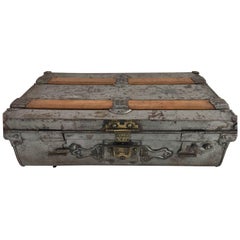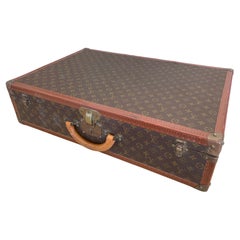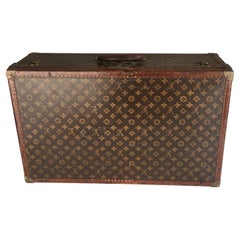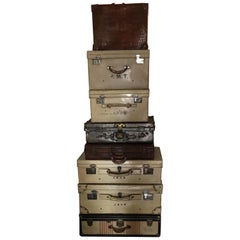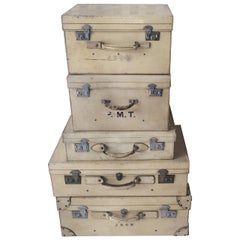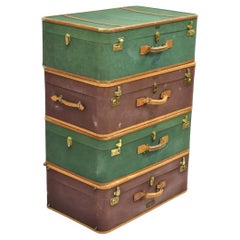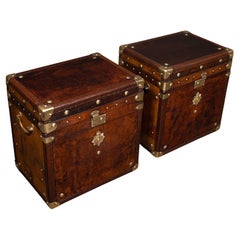Objet d'art Alexandre Ferucci Trunks and Luggage
to
2
5
5
5
1
4
1
4
4
4
2
3
3
2
2
5
5
5
2
1930s Metal Suitcase
Located in Los Angeles, CA
Most unique and unusual 1930s metal suitcase by Jones Brothers & Co. combination of wood and metal with unique hardware.
Category
Mid-20th Century American Trunks and Luggage
Materials
Metal
$1,250
Louis Vuitton Suitcase
By Louis Vuitton
Located in Los Angeles, CA
Louis Vuitton Suitcase in great vintage condition. France, 1940s.
Category
Mid-20th Century French Trunks and Luggage
Materials
Brass
$4,000
Louis Vuitton Vintage Suitcase
By Louis Vuitton
Located in Los Angeles, CA
Vintage suitcase by Louis Vuitton, in great vintage condition. France 1940s.
Category
Vintage 1940s French Trunks and Luggage
Materials
Brass
Set of Eight Vintage Luggage
Located in Los Angeles, CA
Beautiful set of eight (8) vintage luggage in various materials:
Qty one (1): 1930s metal suitcase by Jones Brothers & Co. combination of wood and metal with unique hardware. Dimensions: Height 8 in. (20.32 cm), width 24 in. (60.96 cm), depth 15 in. (38.1 cm)
Qty one (1): alligator skin suitcase, 1940s. Dimensions: Height 8 in. (20.32 cm), width 18.5 in. (46.99 cm), depth 14.5 in. (36.83 cm)
Set of Five Drew & Son Picadilly (Mortar) Pigskin luggage...
Category
Early 20th Century American Trunks and Luggage
Materials
Metal
$4,400 Sale Price / set
20% Off
Set of Pigskin Luggage, 1950s
Located in Los Angeles, CA
Most unique set of Drew & Son Picadilly (Mortar) Pigskin luggage, 1950s. Ralph Lauren's favorite luggage.
Dimensions:
30" L X 18.5" D X 12" H
30" L X ...
Category
Mid-20th Century American Trunks and Luggage
Materials
Leather
$3,200 Sale Price / set
23% Off
Related Items
Vintage T. Anthony Art Deco Leather & Canvas Green Brown Hard Luggage - 4 Pc Set
By T. Anthony
Located in Philadelphia, PA
Vintage T. Anthony Art Deco Leather and Canvas Green & Brown Luggage - 4 Pc Set. Listing includes (2) green suitcases, (2) brown suitcases all with canvas hard case with brown leathe...
Category
Early 20th Century Unknown Art Deco Trunks and Luggage
Materials
Leather, Canvas
$3,500 / set
H 12 in W 33 in D 20 in
Pair, Vintage Officer's Campaign Luggage Cases, English, Bedside Nightstands
Located in Hele, Devon, GB
This is a pair of vintage officer's campaign luggage cases. An English, leather and brass bedside nightstand, dating to the late 20th century period, circa 1970.
Exquisite casework, with beautifully appointed detail and finishes
Displaying a desirable aged patina and in good order throughout
Quality leather tanned to a deep caramel hue with lightly aged finish
Bound to corners with brass cappings over leather straps
Dressed with brass slide clasps, the backplate engraved with the Manx emblem — keys absent
Once open, the lids remain raised upon cornflower blue straps
Bright burgundy coloured textile linings in pleasingly clean order
The tactile lining adorned with brass press stud finish
Military interest to the front fascia, with the Royal Marine Commando - Gibraltar emblem
The emblems bares the regiment motto Per Mare, Per Terram - By Sea and By Land
One lid with stamped monogram for E.J.B.
Brass drop handles adorn either side, for ease of carriage
This is a wonderful pair of vintage officer's campaign luggage cases, the clean appearance and proportion presenting a fine opportunity to use them as distinctive bedside nightstands...
Category
Late 20th Century British Mid-Century Modern Trunks and Luggage
Materials
Brass
$5,186
H 20.08 in W 20.48 in D 14.38 in
20th Century Louis Vuitton Suitcase In Natural Cow Hide, France c.1910
By Louis Vuitton
Located in Royal Tunbridge Wells, Kent
A highly unusual and exceptionally rare Louis Vuitton suitcase, originating from the early years of the 20th century, distinguishes itself not with the globally renowned monogram canvas but with a distinctive covering crafted from a singular piece of cowhide. This unique piece represents a special order from Louis Vuitton, showcasing the brand's historical commitment to utilising only the finest hides available.
Unlike many of its counterparts, leather trunks and cases of this era often struggle to withstand the test of time, requiring regular treatments to prevent drying and disintegration. Remarkably, this particular example defies the odds, retaining the same supple quality it possessed on the day it first graced the shop floor. This suitcase belongs to Louis Vuitton's collection of "speciality materials," which encompasses a diverse range, including, but not limited to, zinc, copper, crocodile leather, and cow leather.
A brief history about Louis Vuitton trunks: Louis Vuitton was born in 1821 to a farmer and milliner and came from a long-established working-class family in eastern France. Vuitton grew up understanding the effects of perseverance and a strong work ethic from watching his family. At the age of 16, he made the decision to walk 292 miles from his hometown to Paris to try and make a new life for himself. When he arrived the city was in the midst of industrialization with current modes of transportation evolving quickly allowing for longer journeys. With this came the need for sturdy travel pieces.
Vuitton was taken as an apprentice for a successful box maker and packer named Monsieur Marechal. He learned to craft durable containers and how to pack them properly – a well-respected profession at the time.In 1854, years after he had mastered his craft and became well respected for it, Vuitton ventured out on his own to open a shop on Rue Neuve des Capucines. It was here that he began to establish himself as a luggage maker. Then, in 1858, Vuitton designed the first Louis Vuitton steamer trunk. At the time trunks had rounded tops to allow for water to run off but this did not allow for convenient stowage. Vuitton introduced a flat, yet waterproof, trunk that was easily stackable. The first of his trunks were outfitted with a grey canvas referred to as Trianon – it wouldn’t be until several decades later that the signature monogram would be introduced.
With a burgeoning business, Vuitton moved his family and workplace to Asniere, where he employed twenty workers to craft his trunks. By 1900 he would have 100 employees, and in 1914 the company would more than double in size. After years of success, Vuitton began to experiment with the design of his luggage by introducing a new striped canvas pattern (1876) and later the still well-known Damier print (1888). The hand-painted patterns were developed to prevent counterfeits. Even in the late 1800s, Louis Vuitton was enough of a status symbol to warrant counterfeiting. In 1886, his son George invented and patented an ingenious locking system that made it impossible to pick the lock of their trunks. This lock is still used today.
1892 would prove to be a time of mourning for the family as Louis Vuitton passed...
Category
20th Century French Other Trunks and Luggage
Materials
Brass
$4,397
H 6.7 in W 25.99 in D 16.93 in
Vintage Safe Deposit Box, Czechoslovakia 1930s
Located in Zohor, SK
Beautiful vintage safe-deposit box in a great functional condition. The box was created in 1930s in Czechoslovakia and works like brand new. Original key...
Category
Vintage 1930s Slovak Mid-Century Modern Trunks and Luggage
Materials
Steel
Ettienne Aigner Hard Suitcase
Located in Tarrytown, NY
Ettienne Aigner hard suitcase.
Category
Early 2000s Trunks and Luggage
Materials
Canvas, Blown Glass
20th Century Louis Vuitton Suitcase Alzer 80, 1970
By Louis Vuitton
Located in Epfach, DE
909481 Alzer 80 80 cm x 26 cm 52.5 cm with removable tray
Louis Vuitton suitcase, Alzer 80 with removable tray, in wonderful, well-kept condition with origin...
Category
20th Century French Trunks and Luggage
Materials
Leather
1930s Art Deco Marble and Green Metal French Birds Bookends
Located in Catania, Sicilia
This is a pair of 1930s Art Deco French bookends. Each bookend features a sculptural bird design made of metal, which exudes an elegant and streamlined aesthetic typical of the Art D...
Category
Mid-20th Century French Art Deco Bookends
Materials
Marble, Metal
Pair of Authentic Louis Vuitton Luggage Pieces
By Louis Vuitton
Located in Los Angeles, CA
Pair of authentic Louis Vuitton luggage pieces.
Individually numbered, pair of brass numbered keys included with both pieces.
Can be moun...
Category
Vintage 1960s French Trunks and Luggage
Materials
Brass
Antique LOUIS VUITTON Leather Hardcase Suitcase – Early 20th Century
By Louis Vuitton
Located in Victoria, BC
A distinguished piece of travel history, this antique Louis Vuitton hardcase suitcase is a fine example of the craftsmanship that defined luxury travel in the early 20th century. Con...
Category
Early 20th Century French Trunks and Luggage
Materials
Leather
Vintage Leather Luggage Valise Suitcase Handbag
Located in New York, NY
Chic leather valise, handbag, suitcase in good, original condition. The bag has two leather grip handles, and a leather closure strap with locking mechanism. The lock is not locked, ...
Category
Mid-20th Century American Art Deco Trunks and Luggage
Materials
Leather
Vintage Louis Vuitton Luggage/Duffle Bag , c. 1980's
By Louis Vuitton
Located in Los Angeles, CA
Vintage Louis Vuitton monogram luggage bag. The exterior of the bag is adorned with the renowned LV monogram pattern and vachetta leather deta...
Category
Vintage 1980s French Trunks and Luggage
Materials
Brass
Large Vintage Louis Vuitton Double Strap Leather Suitcase
By Louis Vuitton
Located in Bradenton, FL
Large Vintage Louis Vuitton leather suitcase. This beautiful piece of luggage features a round top handle and buckle fastenings. Cream colored inside fabric is in good condition and ...
Category
20th Century French Modern Trunks and Luggage
Materials
Leather
